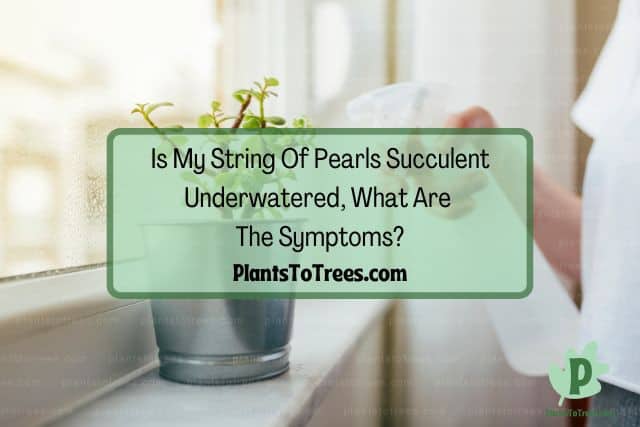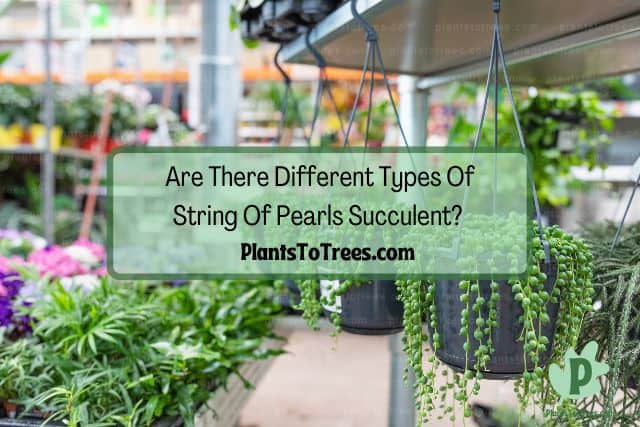String of pearls succulents are an interesting plant that features trailing vines that are covered in pearl-like leaves. It is often grown in hanging baskets, which allow its stunning vines to dangle over and out of the container. Additionally, the string of pearls succulent is an easy-to-care-for plant that is perfect for gardeners of all experience levels.

A string of pearls succulent care guide provides all the information needed to care for this plant. For example, this succulent needs constant temperatures above 70 degrees. They should never be left at temps that are lower than 60 degrees for long periods of time.
The string of pearls succulent also thrives in low humidity, so try to keep this plant out of rooms that are known for higher levels of humidity, such as bathrooms and kitchens.
The string of pearls succulent care guide will also teach you the water, lighting, and soil requirements for this plant, while also discussing the hardiness zones of this plant. Additionally, you will learn what diseases, if any, affect this plant, and we will even visit the toxicity level of the string of pearls succulent.
Other Names Of String Of Pearls Succulent
String of pearls isn’t the only name that this succulent goes by. In fact, it is known by a few different terms. Let’s take a look at what other names it is called.
String Of Pearls succulent is also known as string-of-beads or string-of-bananas. Its scientific name is Curio rowleyanus, but was originally Senecio rowleyanus. String of pearls was named after Gordon Douglas Rowley, a British botanist who specialized in succulents.
Frost Tolerance And USDA Hardiness Zone Of String Of Pearls Succulent
If you want to potentially grow the string of pearls succulent outdoors, you will need to learn whether or not it is frost tolerance, as well as what the hardiness zones are for this succulent.
String of pearls are not frost tolerant and will need to be brought indoors in zones 8 or below. If you live in USDA hardiness zones 9 to 12, you can keep the plant outside all year round. This plant thrives in temperatures between 60 to 80 degrees.
How Many Hours Of Sunlight Does String Of Pearls Succulent Need?

The amount of sunlight a plant needs per day will vary from one species to the next. Giving the plant too much sun can cause dried and burned leaves, while too little light can result in slowed growth.
String of pearls need between 6 and 8 hours of sunlight every day. The sunlight should also be a combination of both indirect and direct sunlight. If the plant doesn’t get this amount of light, then it can experience stunted growth and foliage discoloration.
String Of Pearls Succulent Needs Direct Or Indirect Sunlight?
Direct and indirect sunlight are two very distinctive and different lighting conditions. Trying to grow a plant that needs indirect light in direct light can cause serious and irreversible damage. That is why it is important to learn the lighting needs of the plant beforehand.
String of pearl succulents need a combination of indirect and direct light. For the best results, direct sunlight should be given during the morning hours when the rays are softer, and then indirect light during the harsh rays that occur during the afternoon.
Is String Of Pearls Succulent An Indoor Plant, Outdoor Plant, Or Both?

Some plants can only grow indoors, while others can only grow outside. Some can even be grown both indoors and out. But what about the string of pearls succulent?
Whether or not the string of pearls succulent is an indoor or outdoor plant will depend on where you live. Regions in USDA hardiness zones 9 to 12 can grow this succulent outdoors, while zones 8 and under will need to grow this plant inside.
What Are The Indoor Lighting Requirements?
If you’re growing the string of pearls succulent indoors, you have more control of the lighting situation and can even supplement the plant’s lighting requirements with artificial lights.
When grown indoors, the string of pearl succulent will need both direct and indirect sunlight for 6 to 8 hours a day. Direct sunlight should be provided during the morning hours when the rays are softer and then moved to indirect during the harsh sun that occurs in the afternoon.
What Are The Outdoor Lighting Requirements?
Trying to get the right lighting for string of pearl succulent plants growing outside can be a bit difficult, but not impossible.
Growing the string of pearls succulent outdoors will need similar lighting requirements as if it was growing inside. That means direct light during the morning hours and indirect light during the afternoon hours.
What Soil Requirements Does String Of Pearls Succulent Need?

The string of pearls succulent needs a certain type of soil in order to stay healthy and strong.
The string of pearls succulent will grow well in traditional potting soil. But the best choice is sandy soil that drains well. Alternatively, use cactus potting soil or a mixture of 3 parts potting soil with 1 part sand. No matter what you choose, make sure it has good drainage.
How Much Water Does String Of Pearls Succulent Need?
The amount of water to give your string of pearls succulents can be difficult to determine especially when you learn that this plant doesn’t require much watering.
Like other succulents, string of pearls can tolerate drought-like conditions, but they should still be watered about once every 2 weeks. To help prevent overwatering, wait until the soil has dried out before soaking this plant.
The string of pearls will go through a dormant period during the summer. At this time, watering should be reduced to only about once every 3 weeks. This will help prevent root rot.
Is My String Of Pearls Succulent Overwatered, What Are The Symptoms?
Overwatering a succulent is not something to laugh at. In fact, this easily preventable problem is one of the most serious that can affect string of pearls succulents.
The most common system of an overwatered string of pearls succulent is mushy leaves that have turned dark. The foliage may also have a bumpy texture that wasn’t there before overwatering, and the “pearls” themselves can burst. Yellowing leaves are another sign that this plant has been overwatered.
Once rot has started to form, saving the string of pearls succulent is almost impossible. For most people, the best solution is to trash the infected succulent and start fresh with a new plant.
Is My String Of Pearls Succulent Underwatered, What Are The Symptoms?

Underwatering a string of pearls succulent can be difficult to do because of its tolerance to drought-like conditions. That doesn’t mean, however, that you should purposely withhold water.
While they are drought tolerant, string of pearls succulents can still become underwatered. When this occurs, the plant will use up all the water stored in its leaves. Once the water has been used, the leaves will begin to shrivel. They may also start to feel dry and crispy, and turn yellow or brown.
An underwatered string of pearls succulent can generally be brought back by soaking the plant. This will require filling a container or bucket with water and then submerging the entire plant’s pot into the water. Let the string of pearls succulent soak for 20 to 30 minutes before removing the pot up and out of the water. Let the excessive water drain out of the pot before placing it back in its position.
How Much Fertilizer Does String Of Pearls Succulent Need? What Kind?

Feeding a houseplant helps to encourage strong growth and keep it healthy while also replenishing vital nutrients in the soil.
The string of pearls succulent doesn’t require much feeding, but you can still give this plant fertilizer once a month during its active growing season. Fish emulsion is a good option for this succulent, or you can apply an all-purpose fertilizer at ¼ of its strength.
String Of Pearls Succulent Diseases To Be Aware Of
As with most other types of succulents, the string of pearls is not susceptible to too many diseases. But that doesn’t mean you’re completely in the clear when it comes to potential problems.
We at Plants To Trees first published this article on November 6, 2022. Copyright protected.
Root rot is the most common disease that affects the string of pearls succulent. While this disease is difficult to treat, it is completely preventable. Simply ensure your plant is growing in soil that drains well and avoid overwatering the plant.
Root rot affects the succulent’s ability to move water from the soil to the plant. This disease can occur quickly after only a few episodes of overwatering. That is why it is important to do everything in your power not to allow the succulent’s roots to stay soggy.
Are There Different Types Of String Of Pearls Succulent?

Before you rush out and purchase a string of pearls succulents, learn whether this plant has different cultivars available to help you select the best plant for your needs.
There are not many different types of string of pearls, there is a variegated version called Senecio rowleyanus ‘Variegata’.String of pearls sucuclent is a member of the Senecio genus, which makes up more than 1,000 different types of succulents that feature long vines with a trailing nature.
How To Propagate String Of Pearls Succulent
Propagating string of pearls is not a difficult process, but can be frustrating if you’re not sure how to tackle the task.
The article owner is Plants To Trees dot Com and this article was first published on November 6, 2022.
String of pearls succulent is an easy-to-propagate plant that is propagated via cuttings or offset division. In fact, the string of pearls succulent can be propagated using a single pea! With that said, however, this method has a less success rate than using a cutting of offset.
Once you have your cutting or offset, you can root it in either water or soil.
Is String Of Pearls Succulent Toxic To Humans?
While you may not be worried about whether the string of pearls succulent is toxic since you don’t plan on eating it, the toxicity level is vital information for anyone who has, or plans to have, children in their home.
String of pearls succulents are toxic to humans. When ingested, it can cause gastrointestinal distress, such as vomiting and diarrhea. The sap inside the plant can also cause contact dermatitis, resulting in inflammation, itchiness, redness, and pain.
The good news is that, in most cases, ingestion of the string of pearls won’t lead to serious health complications. But you should still keep this plant out of the reach of children.
Is String Of Pearls Succulent Toxic To Dogs?

Dog owners should always take into consideration whether or not the plant they want to grow poses a risk to their pooch. Let’s take a look at the string of pearls succulent and its toxicity level to canines.
String of pearls are toxic to dogs, and can cause gastrointestinal symptoms like nausea, vomiting, and diarrhea. It can also cause excessive drooling and, in extreme situations, liver failure and muscle convulsions.
The sap of this plant can also cause irritation, itching, and inflammation to the exposed skin. If you suspect your dog has consumed any part of the string of pearls succulent, immediately seek medical attention.
Is String Of Pearls Succulent Toxic To Cats?
Cute, cuddly, and curious, cats and houseplants are not always a good combination. Especially when you consider just how many plants can cause serious health problems for your kitty.
The string of pearls succulents are toxic to cats and can cause a slew of health problems if ingested, including lethargy, nausea, vomiting, and diarrhea. Additionally, the sap naturally found in this plant can cause irritation to their skin.
In most cases, cats won’t eat a large amount of this plant, but that doesn’t mean that you shouldn’t keep this plant out of their reach. Because of the potential health complications that can occur, you should never allow your cat to touch, chew, or bother this plant.
Related Articles
Elephant Bush Succulent Care Guide
Mini Pine Succulent Care Guide
PlantsToTrees.com is the owner of this article and we first published this on November 6, 2022.
